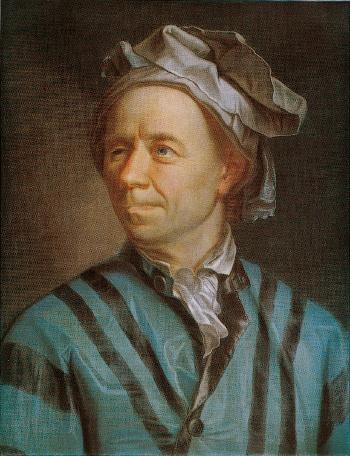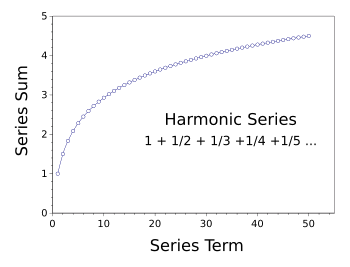Euler on Divergent Series
September 17, 2018
Infinite series can bring great
joy or great
pain. They're wonderful when they
converge, and converge rapidly, but they're a pain when they
diverge. My first introduction to the wonder that's an infinite series was in
elementary school. I had done many
trigonometry homework problems using
trig tables, and I had always thought that these tables were created by expert
draftsmen with precise
protractors and
rulers. It was obvious that they would draw huge
triangles on their
drawing boards,
measure the
sides and
angles very carefully, and then
calculate the
sine,
cosine and
tangent values.

I attended elementary school in Upstate New York, the locale of several indigenous Indian tribes that included the Oneidas, Onondagas, and Mohawks, all of whom were part of the Iroquois Nation. We were taught to remember the trigonometric functions using the mnemonic of an Indian princess named "Sohcahtoa." (Created using Inkscape. Click for larger image.)
How surprised I was when I found that these tables were calculated to great
precision using the
infinite series expansions given below. While
mathematicians are typically less prone to
exaggeration than
scientists, they did decide to use an
exclamation point to signify a
factorial number. The
patterns for the sine and cosine functions are easy to see, but the one for the tangent function is somewhat
obtuse (pun intended).

In these functions, the
angle x is in
radians. While the sine and cosine series are valid for any value of
x, the x-values for the tangent function are restricted to values between
-π/2 to
π/2, since the tangent is
infinity at
90-degrees. There's also an infinite series representation of
e, the
base of the
natural logarithms, as follows,

This fact, coupled with the very strange
imaginary unit,
i, which is the
square-root of
negative one (√-1), gives some other
trigonometric identities, cos(x) = (e
ix + e
-ix)/2, sin(x) = (e
ix - e
-ix)/2i, and tan(x) = (1/i)(e
ix - e
-ix)/(e
ix + e
-ix).
Playing with such series allowed the famous
Swiss mathematician,
Leonhard Euler (707-1783), to devise what's called
Euler's formula

which gives us what's called
Euler's identity when evaluated at x = π,

This combines five interesting
mathematical constants,
0,
1,
e,
i, and
π, into one
equation.

A 1753 pastel portrait of Leonhard Euler by Jakob Emanuel Handmann (1718–1781).
Perhaps keeping his brain warm was one trick that Euler used to create his mathematics, although scientific evidence indicates that people think better when cooler.
(Photograph of a portrait at the Kunstmuseum Basel, via Wikimedia Commons)
Euler was a
voluminous author, as the Euler Archive on the
Mathematical Association of America website will attest.[1]
Alexander Aycock, once at the
Institute of Physics of the
Johannes Gutenberg-Universität Mainz, has published on
arXiv many
translations of Euler's papers from
Latin into
English. He recently published a translation of Euler manuscript (Eneström-Number, E247), "De seriebus divergentibus (On divergent series)."[1] Euler's paper was presented at the
French Academy of Sciences in 1746, and it was published in 1760.
Not all series will sum to a finite results. The series that sum to infinity are called divergent, and it's not always easy to determine whether or not a series will diverge. Lest you think that a series for which the successive terms grow smaller and smaller, becoming zero at infinity, will necessarily converge, there's the example of the
harmonic series
1 + 1/2 + 1/3 + 1/4 + 1/5 + 1/6 + 1/7 + ...
In this series the last term would be zero, but the harmonic series sums to infinity, a fact first deduced by
Nicole Oresme (c.1320-1382), a
polymath of the
Middle Ages. One simple
proof of the divergence of the harmonic series is to consider, instead, the similar series in which elements of the harmonic series are systematically replaced by smaller values, that should sum to a smaller value,
1 + 1/2 + 1/4 + 1/4 + 1/8 + 1/8 + 1/8 + 1/8 + 1/16 + 1/16 + ...
by doing partial sums in this series, we get the equivalent and obviously divergent series,
1 + 1/2 + 1/2 + 1/2 + 1/2 ...

Sum of the harmonic series up to the fiftieth term.
Looks divergent to me, but mathematical rigor demands more than a feeling.
(Created using Gnumeric)
The first part of Euler's manuscript on divergent series deals with
Grandi's_series, which is simply
1 - 1 + 1 - 1 + 1 - 1 + 1 - 1 + ...
This series is interesting enough to have been considered by many mathematicians, including such luminaries as
Gottfried Wilhelm Leibniz (1646-1716),
Jacob Bernoulli (1654–1705),
Daniel Bernoulli (1700-1782),
Jacopo Francesco Riccati (1676-1754),
Joseph-Louis Lagrange (1736-1813),
Augustus De Morgan (1806-1871), and
Ferdinand Georg Frobenius (1849–1917).

Portion of Euler's "De seriebus divergentibus" that discusses Leibniz's analysis of what is now called Grandi's_series. The English translation reads, "From the second species, Leibniz at first considered this series, 1 − 1 + 1 − 1 + 1 − 1 + 1 − 1 + etc., the sum of which he stated to be = 1/2..." (From The Euler Archive Website of the The Mathematical Association of America.[2-3])
One obvious method of analysis of this series is to use the partial sums method we used on the harmonic series. Thus, we can group the series elements as follows;
(1 - 1) + (1 - 1) + (1 - 1) + (1 - 1) + ...
to give us zero. But, what if we group the elements as follows
1 + (-1 + 1) + (-1 + 1) + (-1 + 1) + (-1 + 1) ...
which gives a sum of one. So, which is it, one or zero? Leibniz, in an analysis that was more
philosophical than mathematical, decided to split the difference, and he wrote that the series sums to 1/2 (as revealed in the excerpt of Euler's manuscript shown above). We can get 1/2 as well by a proper grouping and an
algebraic manipulation of the sum
S,
S = 1 + (-1 + 1) + (-1 + 1) + (-1 + 1) + (-1 + 1) ...
1- S = 1 − (1 − 1 + 1 − 1 + ...) = 1 − 1 + 1 − 1 + ... = S
1- S = S
1 = 2S
S = 1/2
Euler notes that the
series expansion of the
algebraic fraction, 1/(1+a), will yield Grandi's_series when a = 1.

and this series has a
residual, the value remaining after summing a finite number of terms, as follows:

This residual is non-zero, so it can't be ignored when n is infinity. After remarking that the objection might be made that there really isn't an infinite term, Euler did another analysis using
finite differences in what's now called the
Euler transform to get the same 1/2 that Leibniz claimed. At this point, there is no
consensus on the sum of this series.
References:
- The Euler Archive, The Mathematical Association of America
- L. Euler, "De seriebus divergentibus“, Novi Commentarii academiae scientiarum Petropolitanae vol. 5, no. 1760 (1760), pp. 205-237, Latin PDF File.
- Alexander Aycock, Translation of Euler's "On divergent Series," arXiv, July 31, 2018.
- Euler's "On divergent Series," English Translation at the Johannes Gutenberg-Universität Mainz Website.
Linked Keywords: Infinite series; pleasure; joy; pain; convergent series; converge; divergent series; diverge; elementary school; trigonometry; homework problem; trigonometric tables; trig tables; drafter; draftsmen; protractor; ruler; triangle; drawing board; measurement; measure; edge (geometry); side; angle; calculation; calculate; sine; cosine; tangent; Upstate New York; Native Americans in the United States; indigenous Indian; tribe; Oneida Indian Nation; Oneidas; Onondaga people; Onondagas; Mohawk people; Mohawks; Iroquois Nation; trigonometric functions; mnemonic; princess; Sohcahtoa; Inkscape; precision; infinite series expansion; mathematician; exaggeration; scientist; exclamation mark; exclamation point; factorial number; pattern; obtuse; angle; radian; infinity; right angle; 90-degrees; e (mathematical constant); radix; base; natural logarithm; imaginary unit; square-root; negative number; trigonometric identities; Switzerland; Swiss; Leonhard Euler (707-1783); Euler's formula; Euler's identity; mathematical constant; 0; 1; e; i; π; equation; pastel; portrait; Jakob Emanuel Handmann (1718–1781); brain; thermal energy; warmth; mathematics; scientific evidence; Kunstmuseum Basel; Wikimedia Commons; voluminous; author; Mathematical Association of America; website; Alexander Aycock; Institute of Physics; Johannes Gutenberg-Universität Mainz; arXiv; translation; Latin; English; French Academy of Sciences; harmonic series (mathematics); Nicole Oresme (c.1320-1382); polymath; Middle Ages; mathematical proof; addition; sum; rigor; Gnumeric; Grandi's series; Gottfried Wilhelm Leibniz (1646-1716); Jacob Bernoulli (1654–1705); Daniel Bernoulli (1700-1782); Jacopo Francesco Riccati (1676-1754); Joseph-Louis Lagrange (1736-1813); Augustus De Morgan (1806-1871); Ferdinand Georg Frobenius (1849–1917); The Euler Archive Website of the The Mathematical Association of America; philosophy; philosophical; algebra; algebraic; series expansion; algebraic fraction; residual; finite difference; Euler transform; consensus.